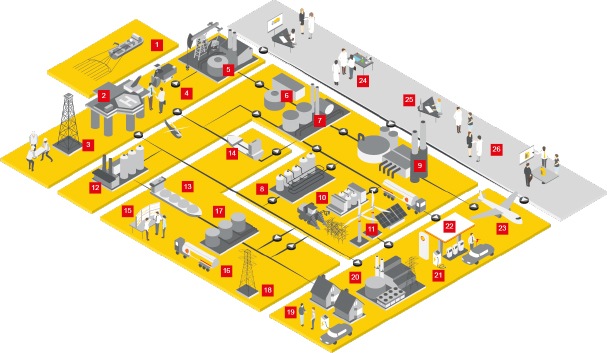United States of America
16,701 Employees
-
Third-party revenues
$53,172,945,048
-
Related-party revenues
$63,068,520,531
-
Total revenues
$116,241,465,579
-
Profit before tax
$(8,388,638,182)
-
Tax paid
$16,617,326
-
Tax accrued
$36,574,605
-
Tangible assets
$61,085,798,314
-
Stated capital
$302,272,053,710
-
Accumulated earnings
$(9,129,606,238)
Main Business Activities
- Upstream
- Downstream
- New Energies [A]
- Manufacturing
- Chemicals
- Trading and Supply
Shell has been present in the USA for more than 100 years. Shell’s exploration and production areas include deep-water oil in the Gulf of Mexico.
Shell has refining, manufacturing and chemical facilities located in Pennsylvania, Alabama, Louisiana, Washington and Texas. In 2021, Shell announced agreements for the sale of refineries in Texas (Deer Park), Alabama (Mobile) and Washington (Puget Sound), and of its Permian business. The sale of the Permian business was completed in December 2021.
Shell’s trading organisation buys and sells more than 5 million barrels of hydrocarbons and 10 billion cubic feet of natural gas every day. It also manages more than 10,000 megawatts of power generation capacity, with a third of this coming from renewable sources.
There are about 14,000 Shell-branded retail sites in the USA and around 2,000 Jiffy Lube locations. Shell has eight light-duty hydrogen fuelling stations in California, with an additional one under construction.
[A] New Energies was rebranded to Renewables and Energy Solutions in 2021.
Country Financial Analysis
The federal statutory corporate income tax rate in the USA is 21%.
Shell reported a loss before tax in 2020 because of the impact of asset impairments, divestments and lower revenues as a result of COVID-19. The tax paid in 2020 includes the corporate income taxes paid to the US federal government and tax paid to state governments where taxable profits were generated. Operating losses incurred in previous years have been offset against earnings and this has resulted in a lower tax paid figure in 2020.
These operating losses were the result of many factors, including investments made in previous years in upstream, manufacturing and chemical businesses during a period of low oil and gas prices. In addition, the decision in 2015 to abandon exploration activities in Alaska and the divestment of a number of non-producing onshore oil and gas leases triggered large tax deductions and generated operating losses.
Our Payments to Governments Report from 2020 also shows payments of around $660 million in royalties and fees.








